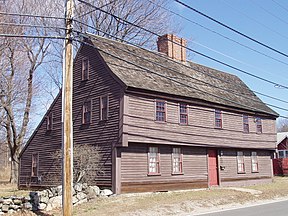Boardman House, Massachusetts
| Boardman House | ||
|---|---|---|
| National Register of Historic Places | ||
| National Historic Landmark | ||
|
Boardman House |
||
|
|
||
| location | Saugus , Massachusetts , United States | |
| Coordinates | 42 ° 28 '20 " N , 71 ° 2' 15.8" W | |
| Built | around 1692 | |
| architect | William Boardman | |
| Architectural style | First Period | |
| NRHP number | 66000131 | |
| Data | ||
| The NRHP added | October 15, 1966 | |
| Declared as an NHL | 5th November 1961 | |
The Boardman House , also known as the Scotch House , Scotch-Boardman House or Bennett-Boardman House , is a historic building in Saugus , Massachusetts . The house, built around 1692, is one of the last two surviving First Period buildings in the city. Boardman House was designated a National Historic Landmark in November 1961 and was added to the National Register of Historic Places in October 1966 .
The Boardman House is a typical representative of the Saltbox architecture ( German salt box ) of the colonial era in New England .
history
In 1686, William Boardman bought some 300 acres of farmland in Saugus, which probably also housed a building, the original Scotch House. Dendrochronological studies date the construction time of the Boardman House, which William built as a residential building for himself and his family, to the year 1692. In the following years an additional kitchen and an extension were built to expand the premises. William Boardman died in 1696 and the house became the property of his son. Since he had a large family, the house was rebuilt and expanded again in 1731. In the mid-19th century, Boardman's descendants began selling much of the farmland. The house itself remained in the family until 1911. It was first sold to Jakob B. Wilbur, and later by him to Clemento D'Andria.
The founder of Historic New England , William Sumner Appleton , acquired the property in 1914 on behalf of the company, recognizing its historical value and the need for protection. With the help of architects and historians, the house has been extensively renovated and returned to almost its original state. Boardman House is still owned by the company and is open to visitors regularly.
Others
The alternative names "Scotch" and "Bennett" are based on a historical error. The English settler Samuel Bennett bought the land in 1648, which William Boardman would later acquire. In Europe the English Civil War was coming to an end at this time . Oliver Cromwell led the Battle of Dunbar in 1650 , during which numerous Scottish soldiers were captured and brought to the American colonies for detention. About 60 of these Scottish prisoners worked in the ironworks in Saugus from 1650 . For this, a residential building was built on Bennett's land, which was called Scotch House and was located near the site of today's Boardman House. Due to inaccurate documents and maps as well as the almost identical age of the buildings, the Boardman House was incorrectly referred to in many records as the Scotch House, since one and the same building was assumed until the 1950s. The actual Scotch House was last mentioned in 1678 and no longer exists today.
See also
literature
- Kevin Murphy: National Register of Historic Places Registration Form. ( PDF ) National Park Service , April 1986, accessed on June 21, 2017 (English, accessible via the INV button ).
Web links
- Photos and plans of Boardman House in the Library of Congress online catalog
Individual evidence
- ↑ Listing of National Historic Landmarks by State: Massachusetts. National Park Service , accessed August 5, 2019.
- ^ Hugh Morrison: Early American Architecture - From the First Colonial Settlements to the National Period . Dover Publications, New York 1952, ISBN 0-486-25492-5 , pp. 55 f . (English, limited preview in Google Book Search).
- ↑ a b c Boardman House (1692) - Remarkably intact for over 300 years. Historic New England, 2017, accessed June 21, 2017 .
- ↑ a b Kathy Weiser: Massachusetts Legends - Historic Sites and Buildings. Legends of America, May 2016, archived from the original on November 23, 2015 ; accessed on August 28, 2019 .
- ↑ Elizabeth S. Levy Merrick: Be There Then - A Guide to Exploring Greater Boston's Historic House Museums . Lulu Publishing, 2014, ISBN 978-1-4834-1923-7 , pp. 13 f . (English, limited preview in Google Book Search).

